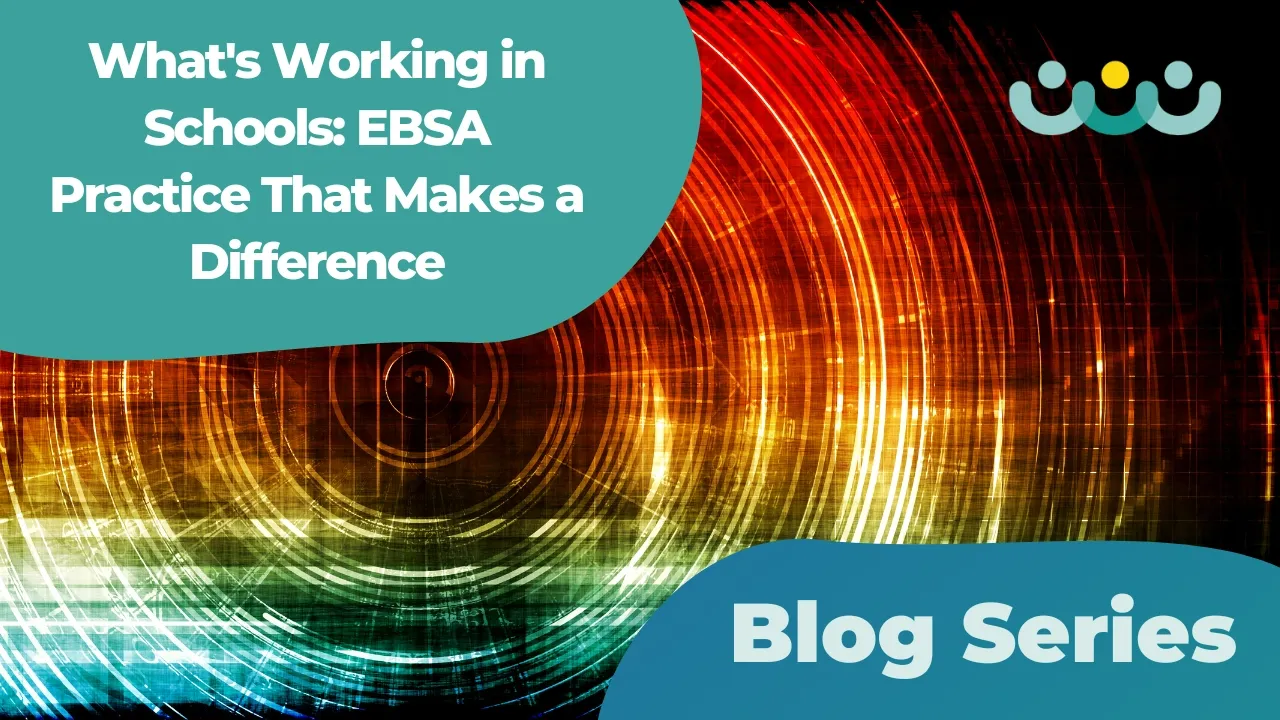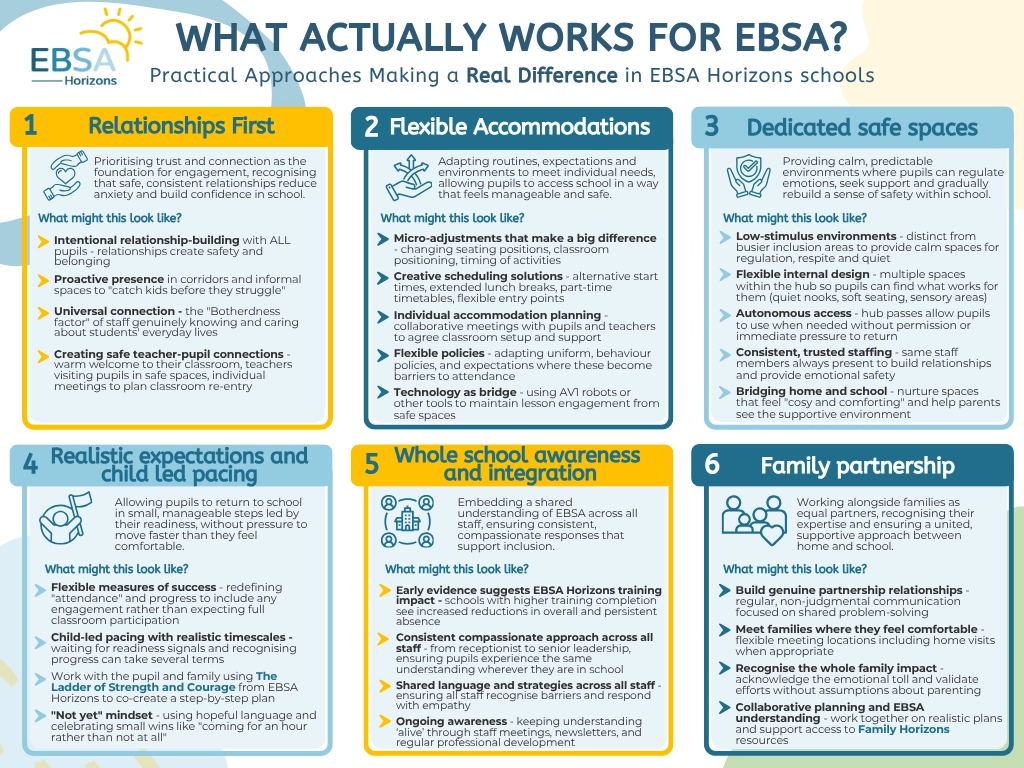What's Working in Schools: EBSA Practice That Makes a Difference
Oct 16, 2025
This is the second blog in our series exploring barriers to education. In the first blog, Shannon Hatton-Corcoran and Rachel Lyons introduced the WARMTH framework - six foundations to reduce barriers to education, recognising that declining attendance is a symptom of unmet need requiring compassionate, proactive approaches.
The WARMTH framework articulates what effective practice looks like. EBSA Horizons training, developed independently but aligned with these principles, provides the mechanism for whole-school implementation and cultural change.
The first blog also highlighted important context: the UK schooling and SEND systems are under huge pressure. This creates ongoing challenges for the wellbeing of both children and staff, reducing retention and flexibility within the workforce. Even when school staff recognise better ways to support young people, there are so many stressors, pressures and demands that moving towards this better way of working may not feel possible.
Through EBSA Horizons training, we've been working with schools to develop understanding and support approaches for children experiencing difficulties attending school and to learn about what is making a difference in their schools.
In our conversations with schools who have undertaken EBSA Horizons training, we're seeing themes emerge about what's making a difference for pupils experiencing barriers to education. These examples demonstrate how schools are translating WARMTH principles into everyday practice.

Relationships First (Wellbeing-first and Relational Approach - WARMTH)
What schools are doing
Staff talked about something called the "botheredness factor" - genuinely knowing and caring about pupils' everyday lives. This reflects a wellbeing-first, relational approach where relationships are the foundation for creating environments where young people feel safe, can learn, and can thrive. Schools shared that this wasn't just about pastoral teams or key adults, it's intentional relationship-building with all pupils.
Schools describe:
- Having a proactive presence in corridors and informal spaces to "catch kids before they struggle"
- Creating safe teacher-pupil connections through warm welcomes to classrooms - greeting pupils by name, positive tone-setting as they enter the learning space
- Getting to know pupils as people - learning about their lives outside school, their interests, what they're dealing with, what matters to them
- When children do struggle to enter the classroom, teachers visited pupils in safe spaces rather than expecting pupils to come to them
- Individual meetings between pupils and teachers to plan classroom re-entry together
Schools talk about "universal connection" - relationships creating safety and belonging for all pupils, not just those already identified as struggling. This relational approach means supporting young people from a foundation of trusting relationships, recognising that this is essential for wellbeing and sense of safety and belonging within schools.
Flexible Accommodations (Affirming Practice - WARMTH)
What schools are doing
Schools are describing practice that reflects affirming approaches - recognising that everyone is different and that accommodating for these differences ensures all pupils can access education. Rather than expecting young people to adapt to a "standard pathway," schools are adapting environments and expectations to meet individual needs.
Staff talked about making "micro-adjustments that make a big difference":
- Changing seating positions, classroom positioning, timing of activities
- Creative scheduling solutions: alternative start times, extended lunch breaks, part-time timetables, flexible entry points
- Individual accommodation planning: collaborative meetings with pupils and teachers to agree classroom setup and support
- Flexible policies: adapting uniform, behaviour policies, and expectations where these become barriers to attendance
- Technology as bridge: using AV1 robots or other tools to maintain lesson engagement from safe spaces
Dedicated Safe Spaces (Holistic Support, Mutual Support and Partnership and Affirming Practice - WARMTH)
What schools are doing
Schools describe creating low-stimulus environments that are distinct from busier inclusion areas - spaces specifically designed to provide calm spaces for regulation, respite and quiet.
The effective examples have:
- Flexible internal design with multiple spaces within the hub so pupils can find what works for them (quiet nooks, soft seating, sensory areas)
- Autonomous access: hub passes allow pupils to use spaces when needed without permission or immediate pressure to return
- Consistent, trusted staffing: same staff members always present to build relationships and provide emotional safety
- Bridging home and school: nurture spaces that feel "cosy and comforting" and help parents see the supportive environment
Realistic Expectations and Child-Led Pacing (Timely Response, Affirming Practice and Wellbeing First - WARMTH)
What schools are doing
When children did experience difficulties attending, schools talked about allowing pupils to return in small, manageable steps led by their readiness, without pressure to move faster than they feel comfortable.
They're:
- Using flexible measures of success: redefining "attendance" and progress to include any engagement rather than expecting full classroom participation
- Working with child-led pacing with realistic timescales: waiting for readiness signals and recognising progress can take several terms
- Using tools like The Ladder of Strength and Courage from EBSA Horizons to work with pupils and families to co-create step-by-step plans
- Adopting a "not yet" mindset: using hopeful language and celebrating small wins like "coming for an hour rather than not at all"
Whole School Awareness and Integration
What schools are doing
This is where we see the distinctive impact of EBSA Horizons training - not just introducing practices aligned with WARMTH principles, but embedding them as whole-school culture. The WARMTH framework articulates what effective practice looks like; the whole-school training model provides the mechanism for these principles to become embedded practice rather than isolated initiatives.
Schools describe:
- Consistent compassionate approaches across all staff roles, which means that children consistently experience the school environment as supportive
- Shared language and strategies - staff across the school using the same concepts and approaches
- Understanding that's kept alive through staff meetings, newsletters, and regular professional development
Early evidence from a Local Authority project in which EBSA Horizons training was made available to all staff in school and across their Local Authority, suggests an association between course completion and attendance data, with schools with the highest completion (i.e., whole school engaging with the training) seeing greater reductions in overall and persistent absence.
Whilst it was harder to achieve, it was felt that there was a fundamental difference between isolated pockets of good practice and whole-school, consistent understanding:
- One staff member offering a safe space vs all staff understanding why safe spaces matter and supporting their use
- A SENCO implementing flexible accommodations vs all teachers feeling empowered to adapt
- Individual relationships with key adults AND universal connection across all interactions
When understanding sits only with a few people, practice depends entirely on those individuals. When understanding is shared across the school - while still having champions who lead conversations and keep understanding alive - it becomes embedded in how the school supports young people more generally.
Training as a tool for embedding practice
What we're learning is that the schools do not see that EBSA Horizons training is a one-off event. It's a tool to change practice and embed conversations and approaches into school culture. Schools shared that the training was the beginning of ongoing dialogue - keeping understanding alive through regular staff discussions, and embedding EBSA awareness and a wellbeing-first approach into how they talk about attendance.
Family Partnership (Holistic and Mutual Support and Partnership- WARMTH)
What schools are doing
Staff describe approaches that genuinely partner with families, recognising the integral role families play in supporting children's wellbeing and education:
- Building genuine partnership relationships: regular, non-judgmental communication focused on shared problem-solving
- Meeting families where they feel comfortable: flexible meeting locations including home visits when appropriate
- Recognising the whole family impact: acknowledging the emotional toll and validating efforts without assumptions about parenting
- Collaborative planning and EBSA understanding: working together on realistic plans and supporting access to Family Horizons resources
Reflections on Practice
It has been rewarding to hear about practice within schools making a difference to children's wellbeing and engagement in school, which in turn has an impact on attendance. We cannot thank schools enough for their commitment to this work and sharing what is working to make a difference in their schools. We recognise this practice is being implemented in incredibly challenging circumstances, under significant system pressures. Through our conversations with schools undertaking EBSA Horizons training, we're seeing practice that makes a tangible difference.
What's equally significant is how this work is changing schools' approaches more broadly. The WARMTH framework provides the principles; whole-school training provides the mechanism for cultural change. The understanding gained through supporting these children has the potential to reshape how schools think about and respond to all pupils' needs, creating school environments that better meet all pupil's needs.
Want to see these practices in detail?
Download our full case studies showing how schools are implementing these approaches:
EBSA Practice That Makes a Difference - Real Examples from Schools
Interested in EBSA Horizons training for your school?
Learn more about how whole-school training can support your setting to develop consistent, effective EBSA practice:
EBSA Horizons School Staff Training
EBSA Horizons School Training is a comprehensive CPD course for School Staff, which develops understanding and skills (alongside a lot of resources) to support children and young people experiencing difficulties attending school. This course has recently been updated with a new chapter.
Find out more about EBSA Horizons School Training here and register your interest to receive 3 FREE resources from this course.
Family Horizons: Nurturing School Engagement and Wellbeing
Family Horizons offers parents and carers on-demand access to practical strategies, knowledge, and tools across five carefully structured chapters. From understanding attendance challenges to supporting anxiety and promoting family wellbeing, the course brings together professional expertise with real family experiences.
Find out more about Family Horizons here.
Stay connected with news and updates!
Sign up to receive updates, resources, inspiring blogs and early access to our courses.
Don't worry, your information will not be shared.



